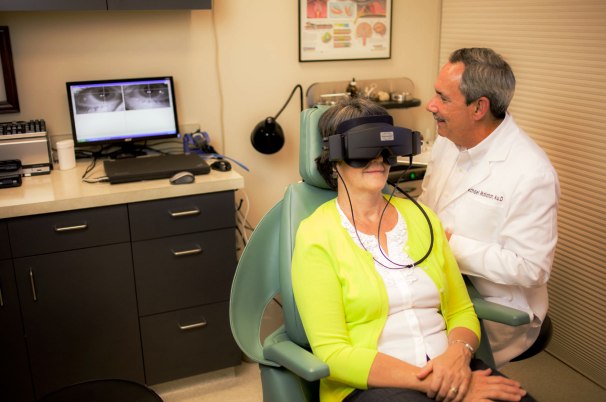What is videonystagmography (VNG)?
Videonystagmography (VNG) is a test that measures a type of involuntary eye movement called nystagmus. These movements can be slow or fast, steady or jerky. Nystagmus causes your eyes to move from side to side or up and down, or both. It happens when the brain gets conflicting messages from your eyes and the balance system in the inner ear. These conflicting messages can cause dizziness.You can briefly get nystagmus when you move your head a certain way or look at some types of patterns. But if you get it when you don't move your head or if it lasts a long time, it may mean you have a disorder of the vestibular system.
Your vestibular system includes organs, nerves, and structures that are in your inner ear. It is your body's main center of balance. The vestibular system works together with your eyes, sense of touch, and brain. Your brain communicates with the different systems in your body to control your balance.
Other names: VNG.
What is it used for?
VNG is used to find out if you have a disorder of the vestibular system (the balance structures in your inner ear) or in the part of the brain that controls balance.Why do I need a VNG?
You may need a VNG if you have symptoms of a vestibular disorder. The main symptom is dizziness, a general term for different symptoms of imbalance. These include vertigo, a feeling that you or your surroundings are spinning, staggering while walking, and lightheadedness, a feeling like you are going to faint.Other symptoms of a vestibular disorder include:
- Nystagmus (involuntary eye movements that go side to side or up and down)
- Ringing in the ears (tinnitus)
- Feeling of fullness or pressure in the ear
- Confusion
What happens during a VNG?
A VNG may be done by a primary health care provider or one of the following types of specialists:- An audiologist, a health care provider who specializes in diagnosing, treating, and managing hearing loss
- An otolaryngologist (ENT), a doctor specializing in treating diseases and conditions of the ears, nose, and throat
- A neurologist, a doctor specializing in diagnosing and treating disorders of the brain and nervous system
- Ocular testing. During this part of the VNG, you will watch and follow moving and nonmoving dots on a light bar.
- Positional testing. During this part, your provider will move your head and body in different positions. Your provider will check if this movement causes nystagmus.
- Caloric testing. During this part, warm and cool water or air will be put in each ear. When cold water or air enters the inner ear, it should cause nystagmus. The eyes should then move away from the cold water in that ear and slowly back. When warm water or air is put in the ear, the eyes should move slowly toward that ear and slowly back. If the eyes don't respond in these ways, it may mean there is damage to the nerves of the inner ear. Your provider will also check to see if one ear responds differently from the other. If one ear is damaged, the response will be weaker than the other, or there may be no response at all.
Will I need to do anything to prepare for a VNG?
You may need to make changes in your diet or avoid certain medicines for a day or two before your test. Your health care provider will let you know if there are any special instructions to follow.Are there any risks to a VNG?
The test may make you feel dizzy for a few minutes. You may want to make arrangements for someone to drive you home, in case the dizziness lasts for a longer period of time.What do the results mean?
If the results were not normal, it may mean you have a disorder of the inner ear. These include:- Meniere's disease, a disorder that causes dizziness, bouts of hearing loss, and tinnitus (ringing in the ears). It usually affects only one ear. Although there is no cure for Meniere's disease, the disorder may be managed with medicine and/or changes in your diet.
- Labyrinthitis, a disorder that causes vertigo and imbalance. It is caused when part of the inner ear becomes infected or swollen. The disorder sometimes goes away on its own, but you may be prescribed antibiotics if you are diagnosed with an infection.
If you have questions about your results, talk to your health care provider.
Is there anything else I need to know about a VNG?
Another test called electronystagmography (ENG) measures the same type of eye movements as a VNG. It also uses ocular, positional, and caloric testing. But instead of using a camera to record eye movements, an ENG measures eye movements with electrodes placed on the skin around the eyes.While ENG testing is still being used, VNG testing is now more common. Unlike an ENG, a VNG can measure and record eye movements in real time. VNGs can also provide clearer pictures of eye movements.
This health news has been brought to you by the publishers of Health Reviews, Tips and News Website. Visit today for great health tips and reviews.




No comments
Post a Comment